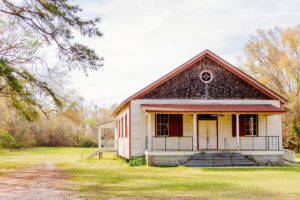We hope this Lowcountry picture might be a little easier for folks to identify. What and where is it? Send to editor@charlestoncurrents.com. And don’t forget to include your name and the town in which you live.
Our previous Mystery Photo
 Our Sept. 14 photo, “Lonely building,” isn’t all that lonely. It’s Darrah Hall, one of several buildings at the historic Penn Center on St. Helena Island in Beaufort County. Mary Greene of Columbia, who identified the photo, reminded us that the Penn Center is “now part of the Reconstruction Park declared by President Obama before he left office.”
Our Sept. 14 photo, “Lonely building,” isn’t all that lonely. It’s Darrah Hall, one of several buildings at the historic Penn Center on St. Helena Island in Beaufort County. Mary Greene of Columbia, who identified the photo, reminded us that the Penn Center is “now part of the Reconstruction Park declared by President Obama before he left office.”
Only a few others correctly identified the photo: Marnie Huger of Richmond, Va., Donald Skaggs of Charleston; George Graf of Palmyra, Va.; and Allan Peel of San Antonio, Texas.
Graf added: “At the outbreak of the American Civil War in 1861, Union Army forces quickly captured Saint Helena Island, prompting the local plantation owners to flee. The military administration of the island partitioned the old plantations, giving the land to the former slaves who lived there. The Penn School was established in 1862 by Laura Matilda Towne, an abolitionist missionary from Pittsburgh, Pa., as a school for the freed slaves, which was named for William Penn, Quaker champion for human liberty and founder of Pennsylvania.”
Peel shared, “Today’s mystery photo in the Charleston Currents is of the Darrah Hall, the oldest surviving building at the Reconstruction Era National Historical Park, on St. Helena Island, S.C. The building is part of the Penn Center, a cultural and educational center that evolved from the Penn School, one of the first southern schools founded by Quaker and Unitarian missionaries from Pennsylvania. It was the first school founded in the Southern United States specifically for the purpose of educating formerly enslaved African-Americans during the Reconstruction Era (1861-1900). The Penn Center Campus was designated a National Historic Landmark District in 1974. Interestingly, the Penn Center was not listed on the National Landmark of Historic Places for its architecture, but rather for its contributions to black history and social justice.”
- Send us a mystery: If you have a photo that you believe will stump readers, send it along (but make sure to tell us what it is because it may stump us too!) Send it along to editor@charlestoncurrents.com.




 We Can Do Better, South Carolina!
We Can Do Better, South Carolina!
























